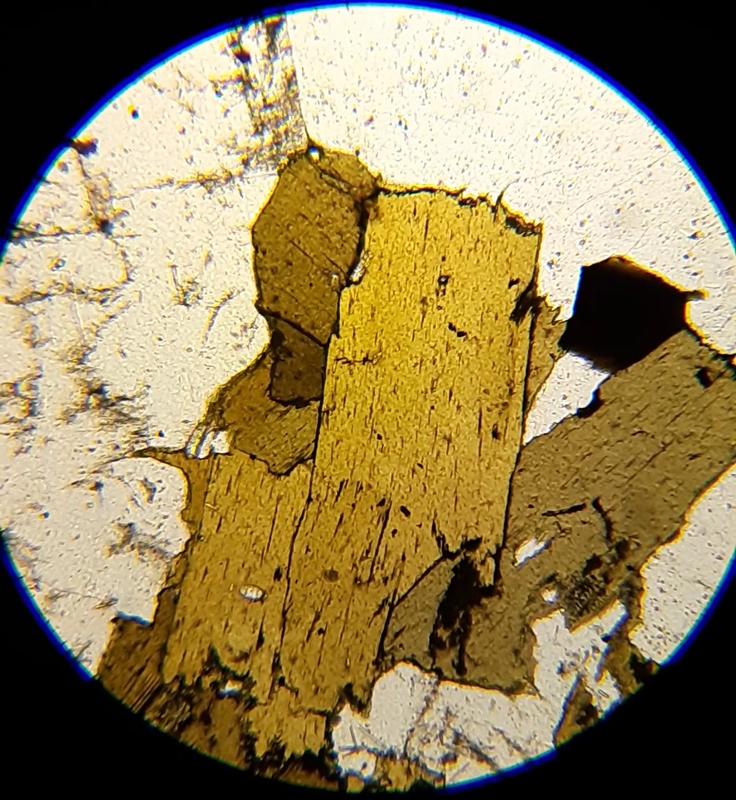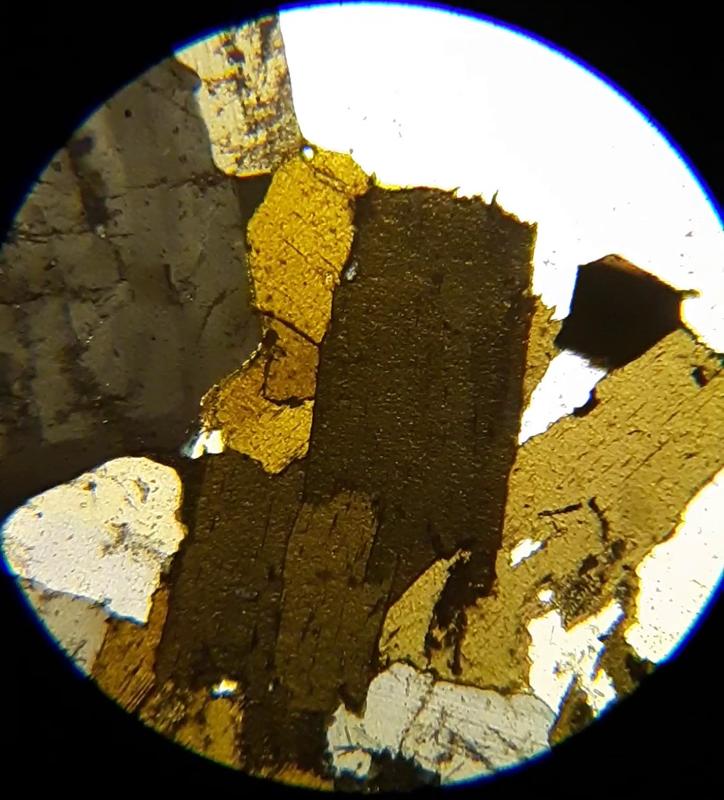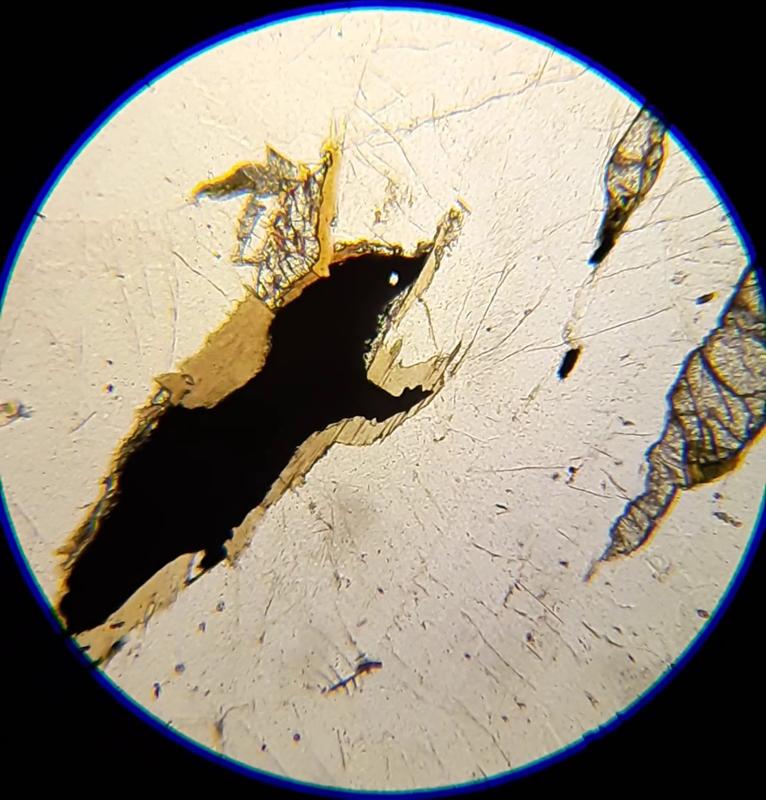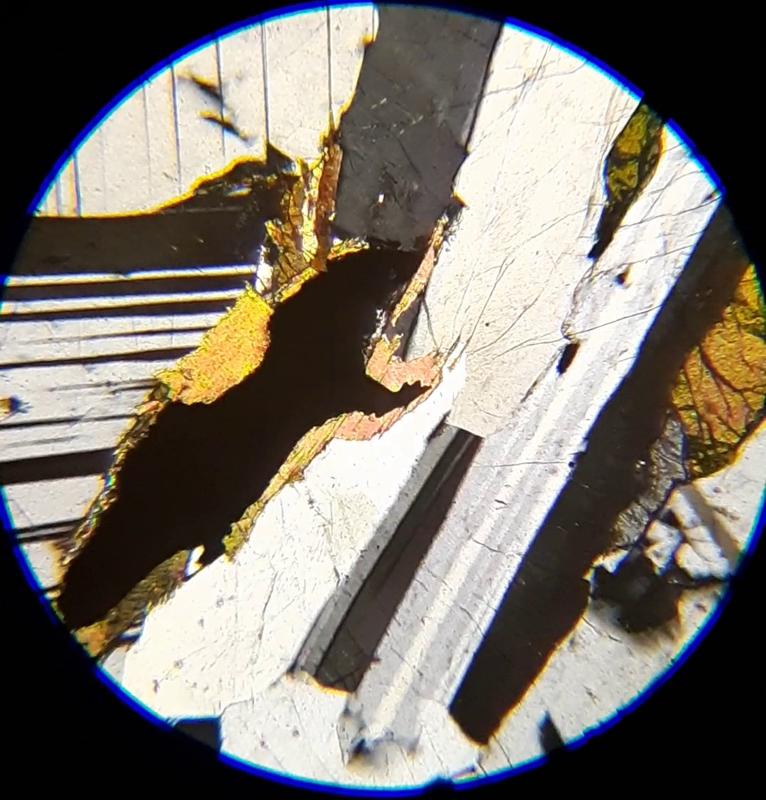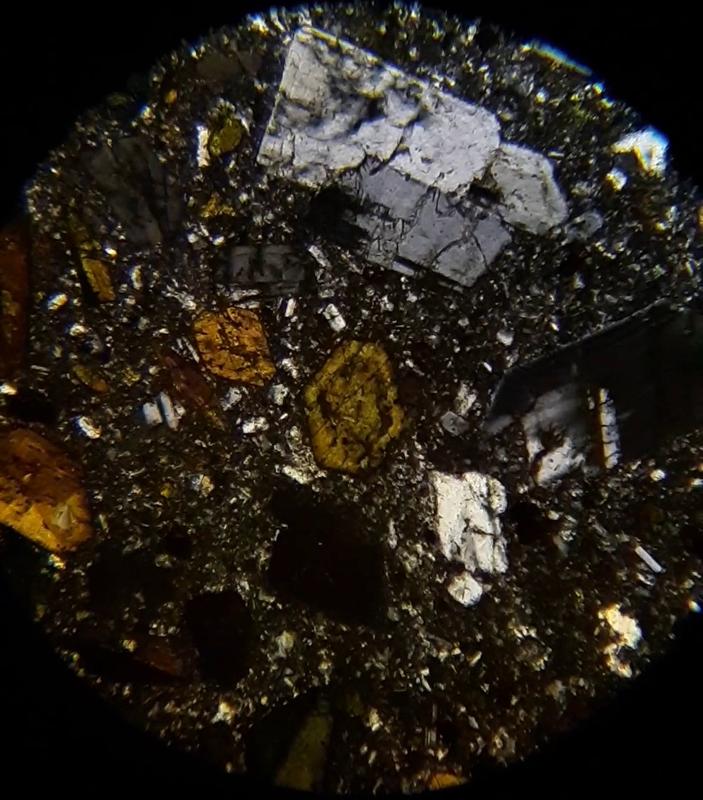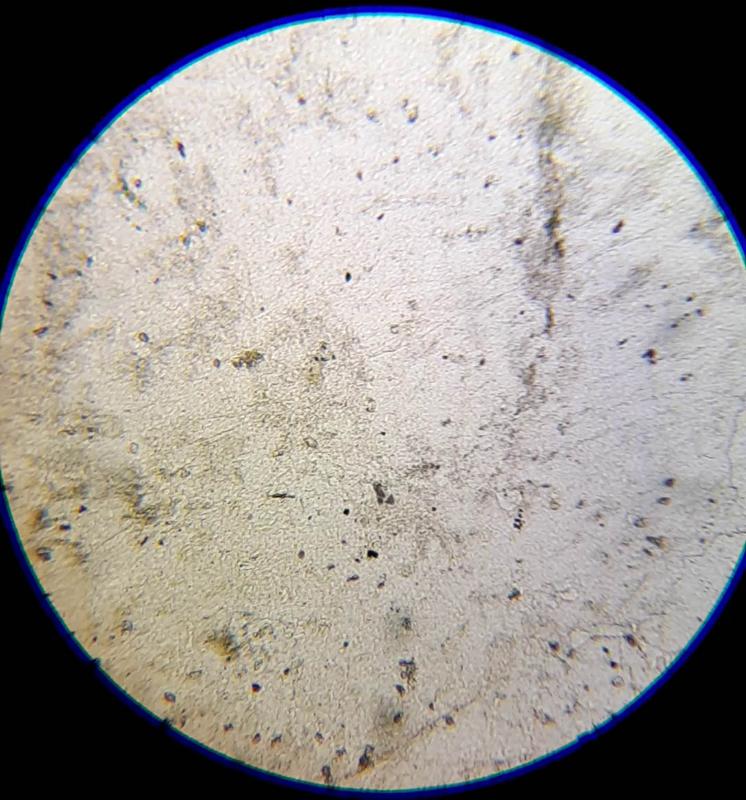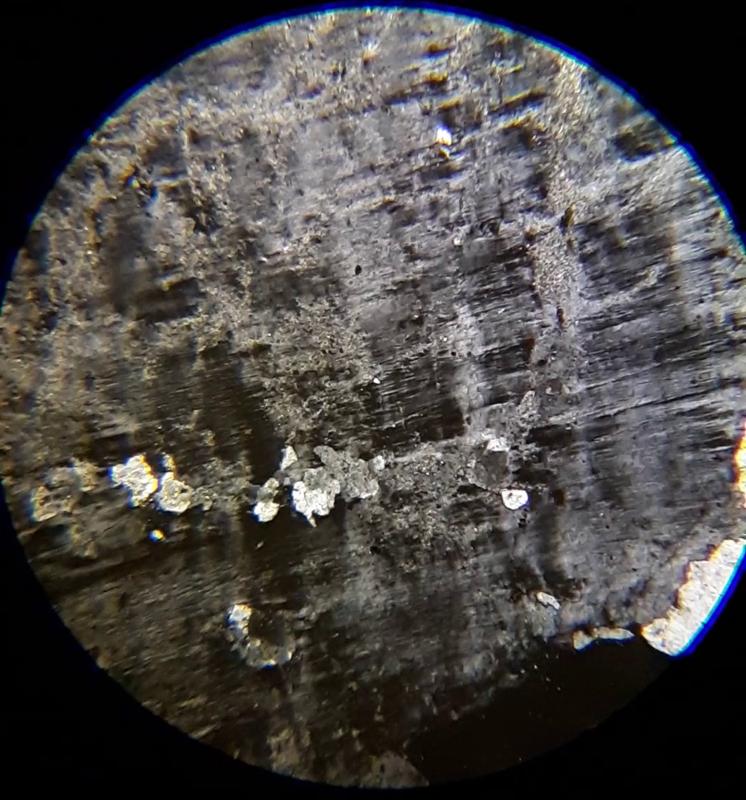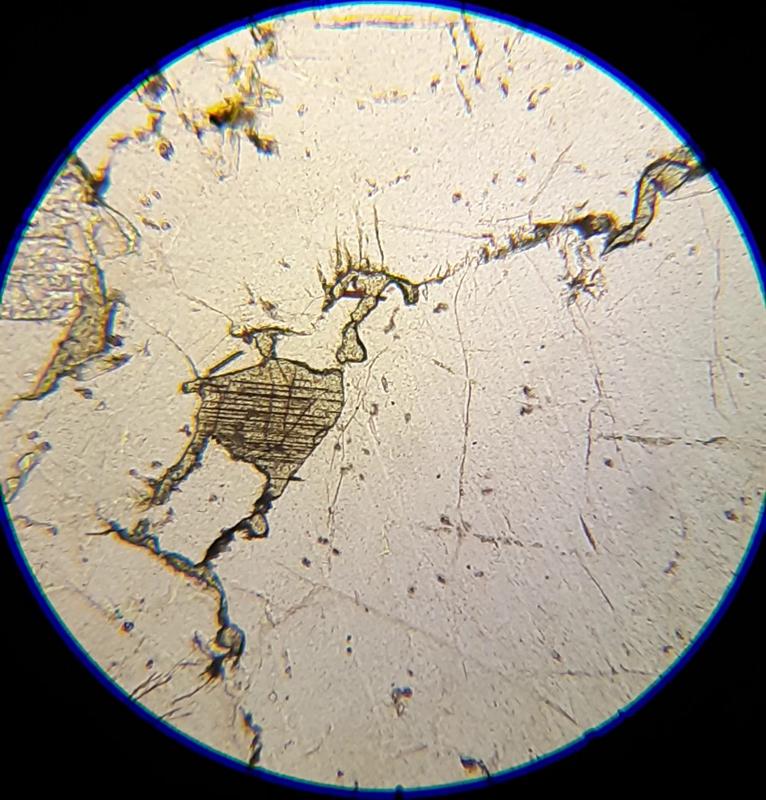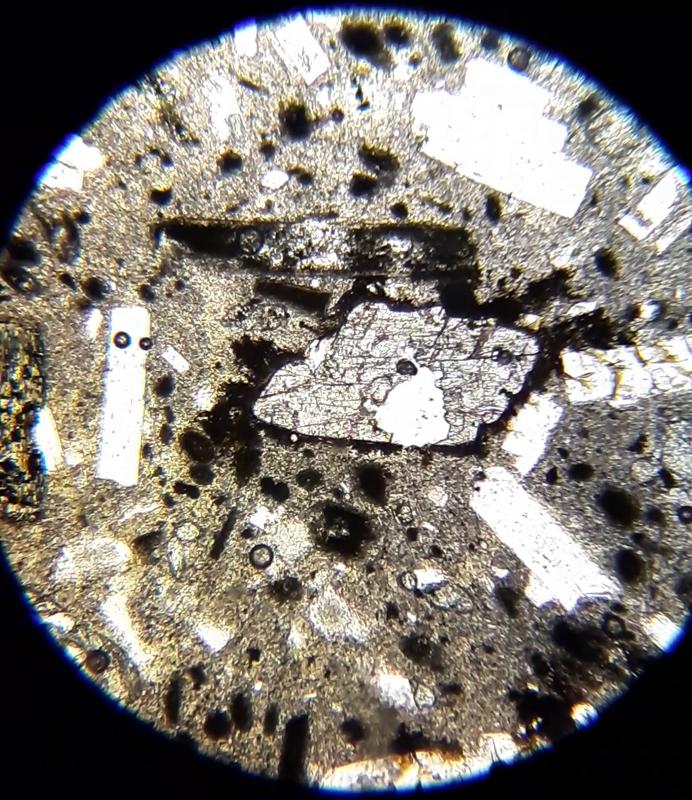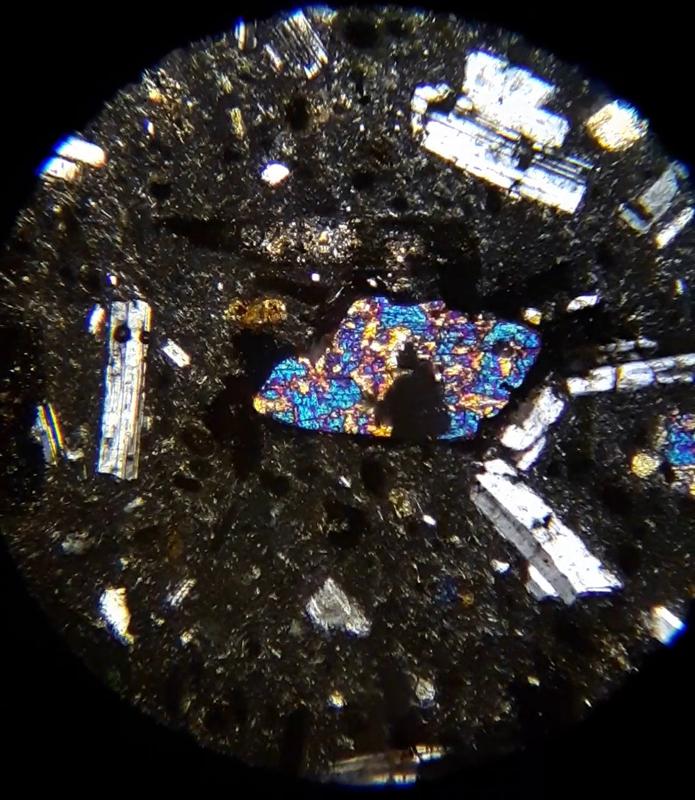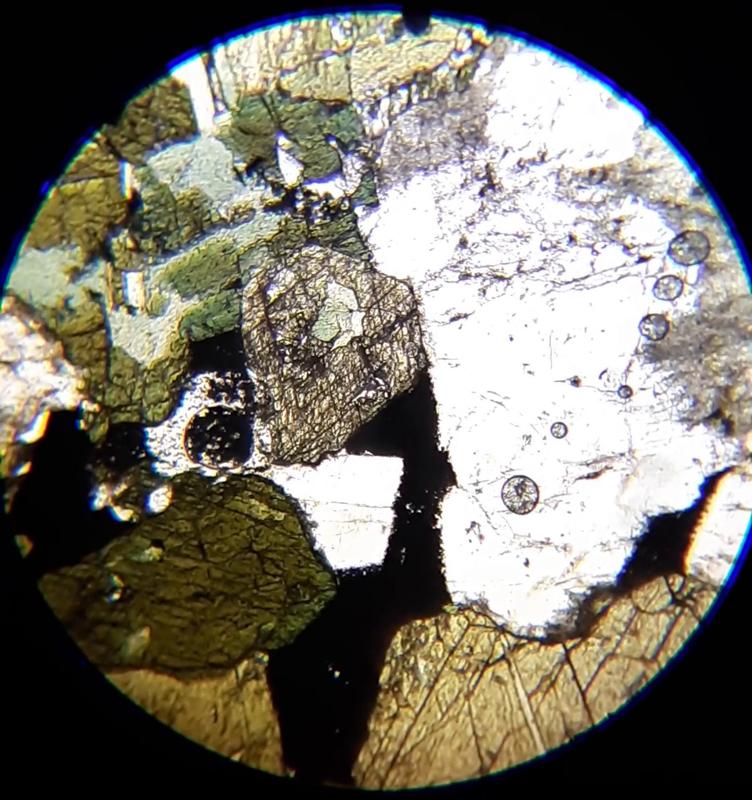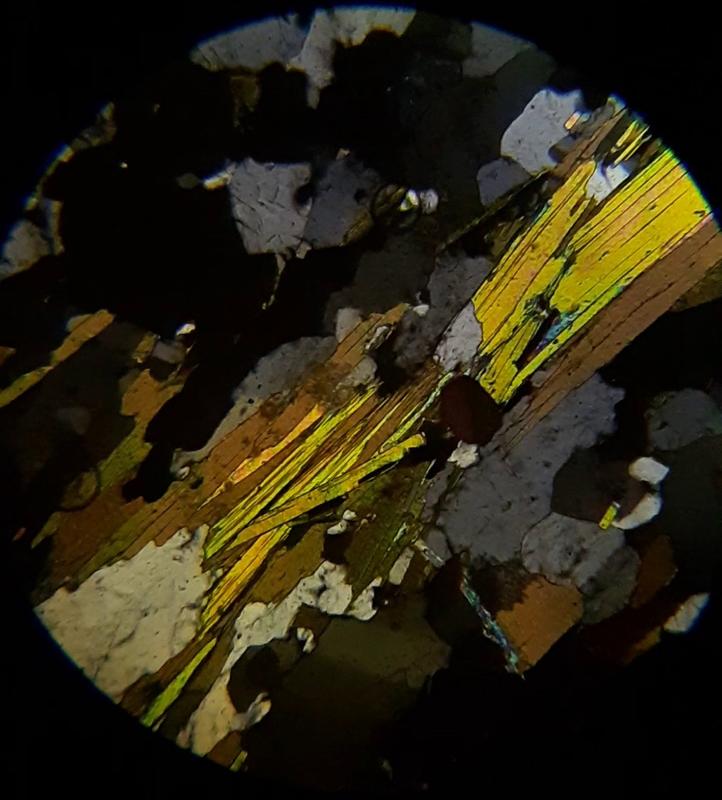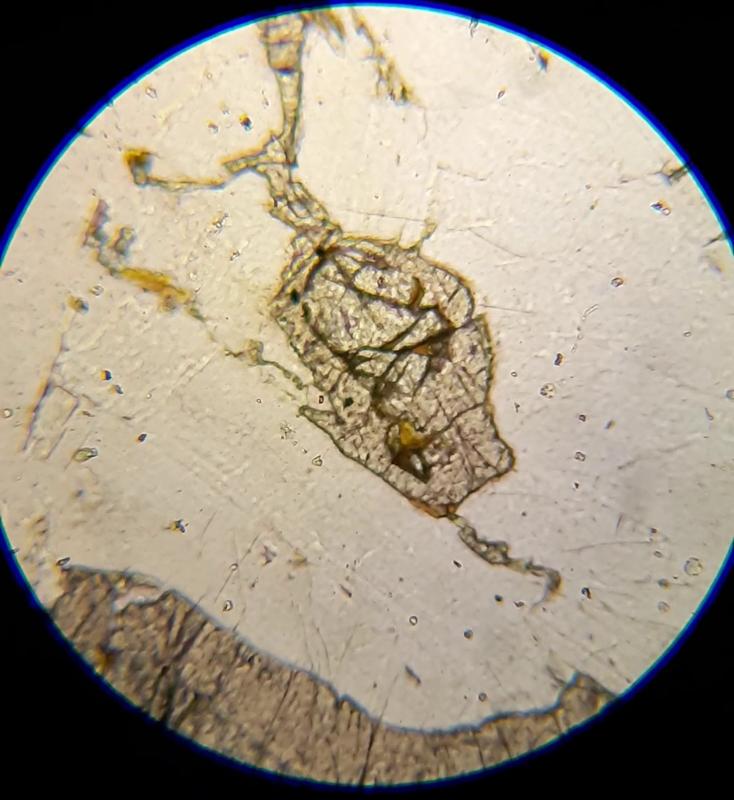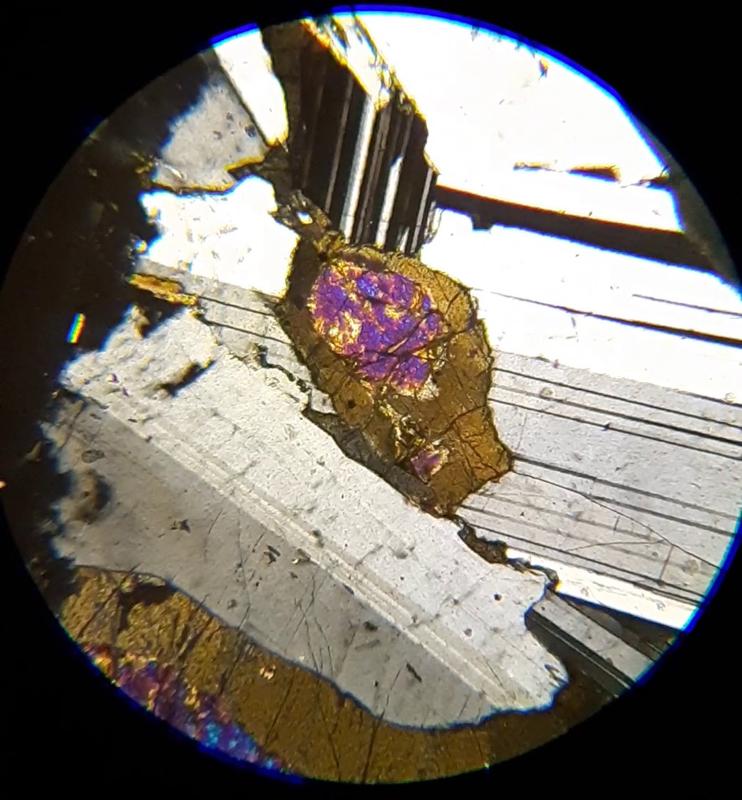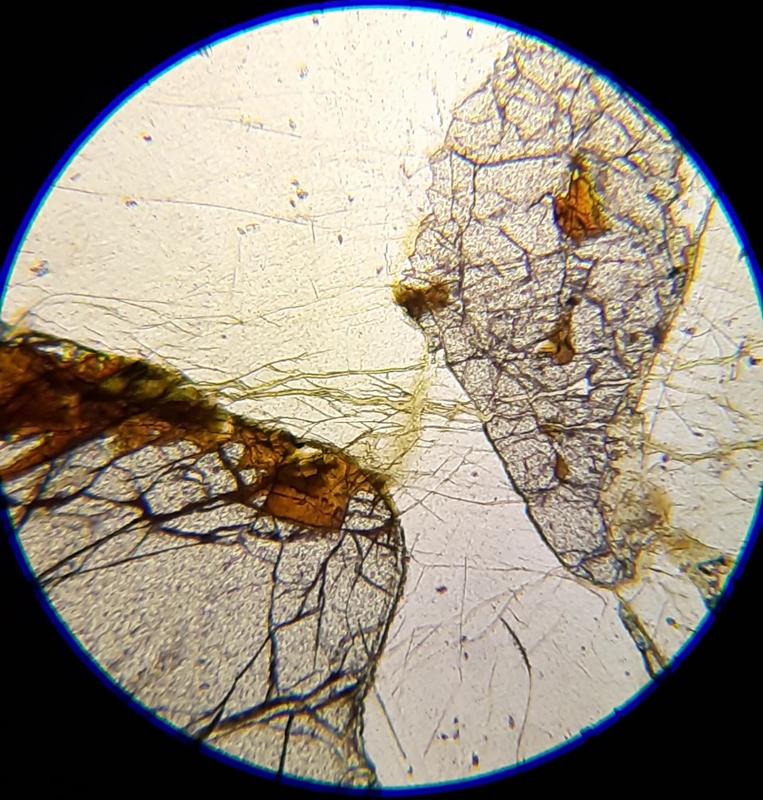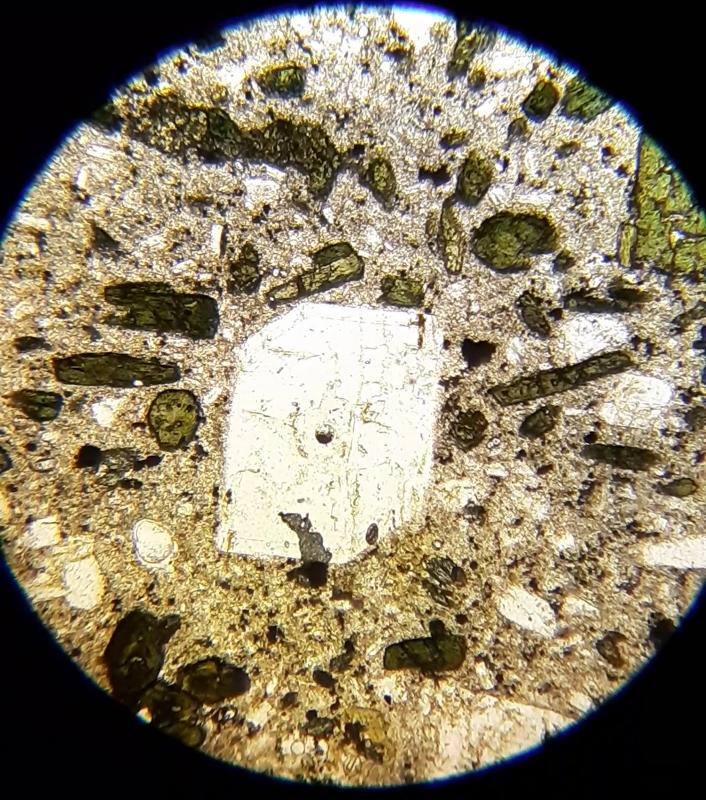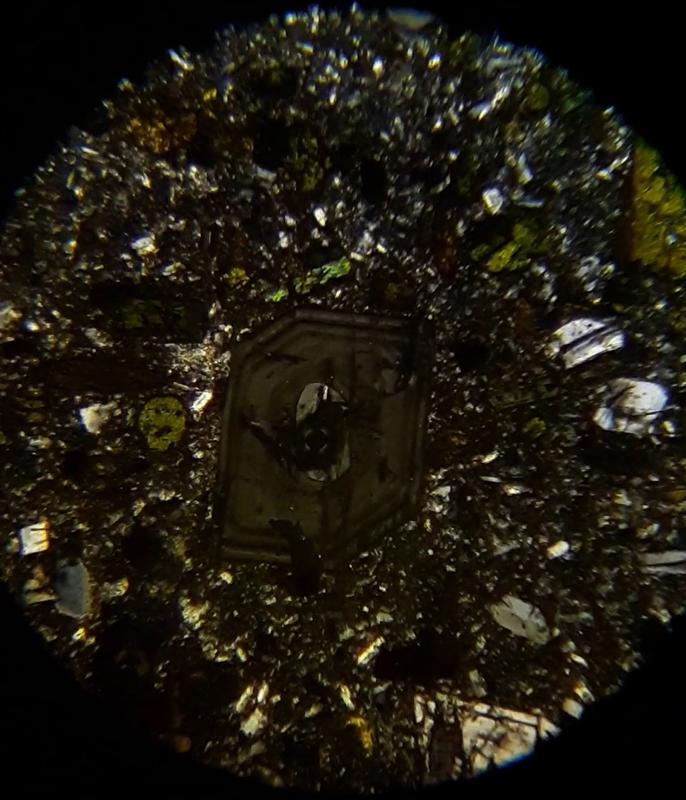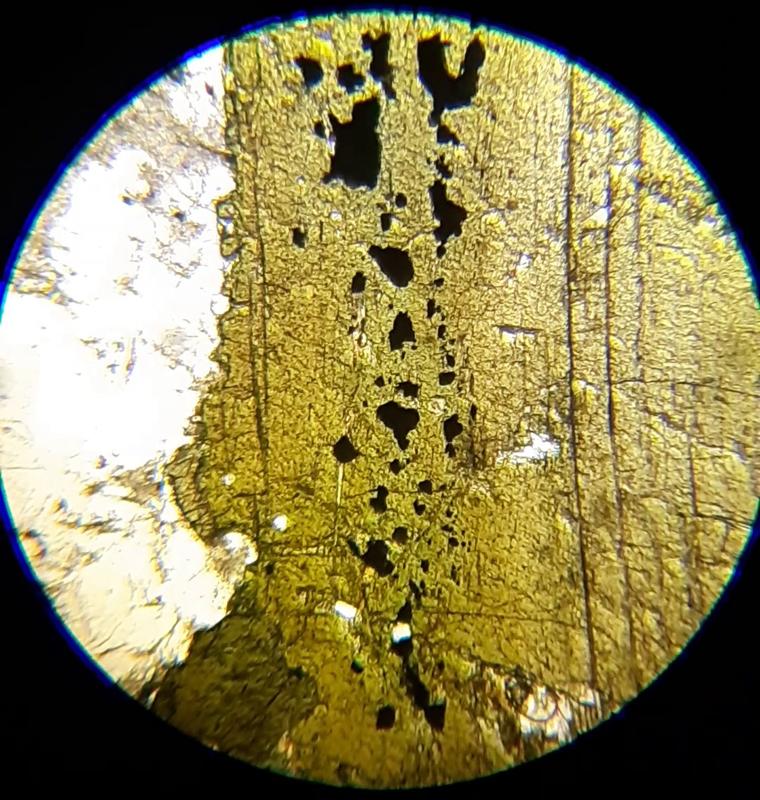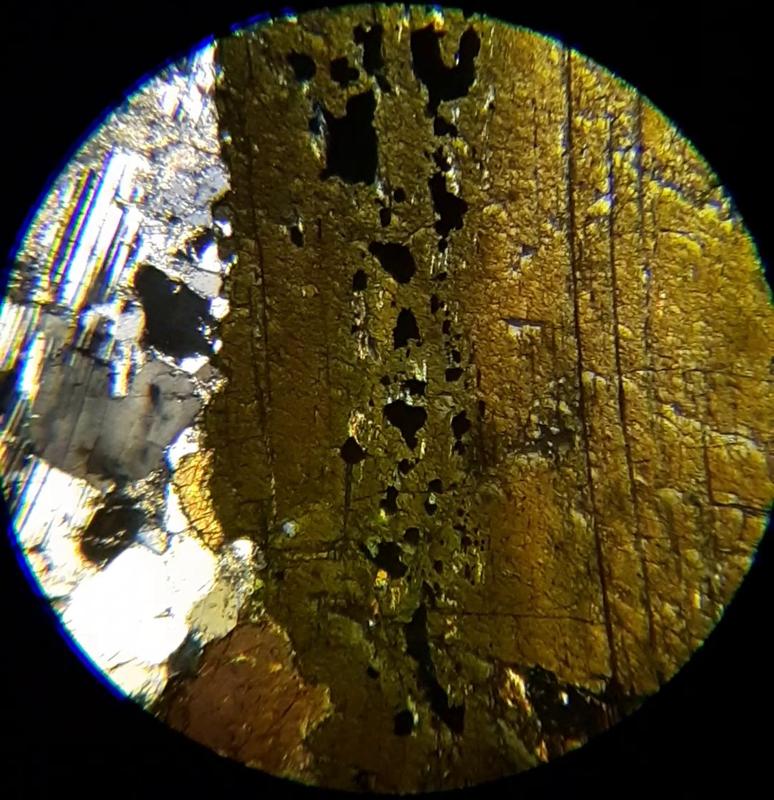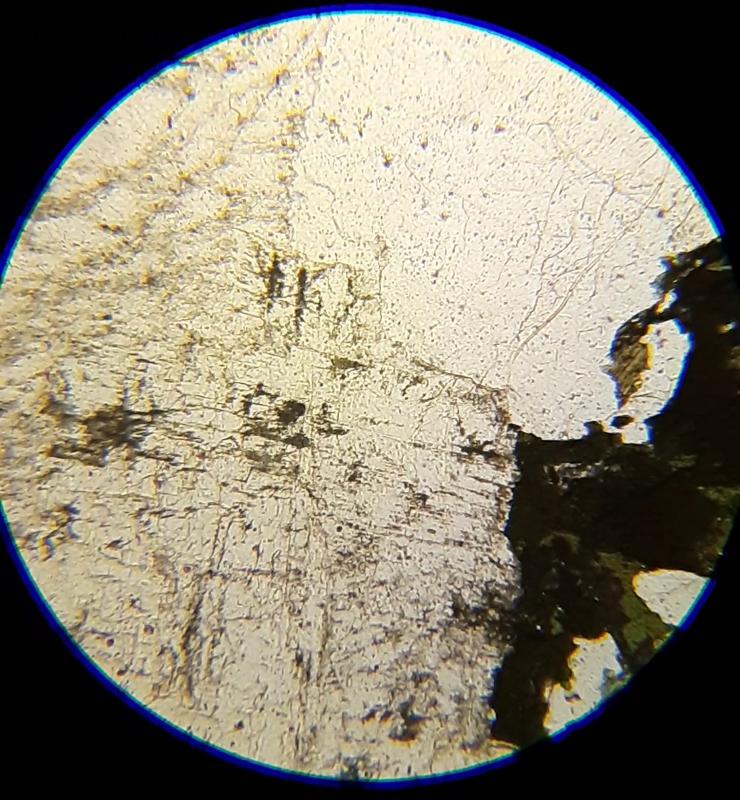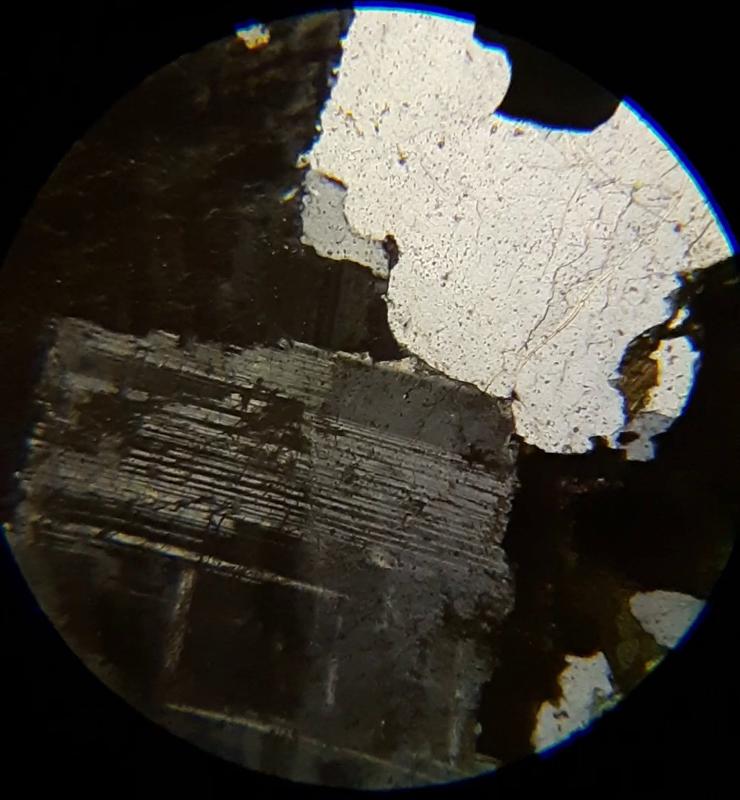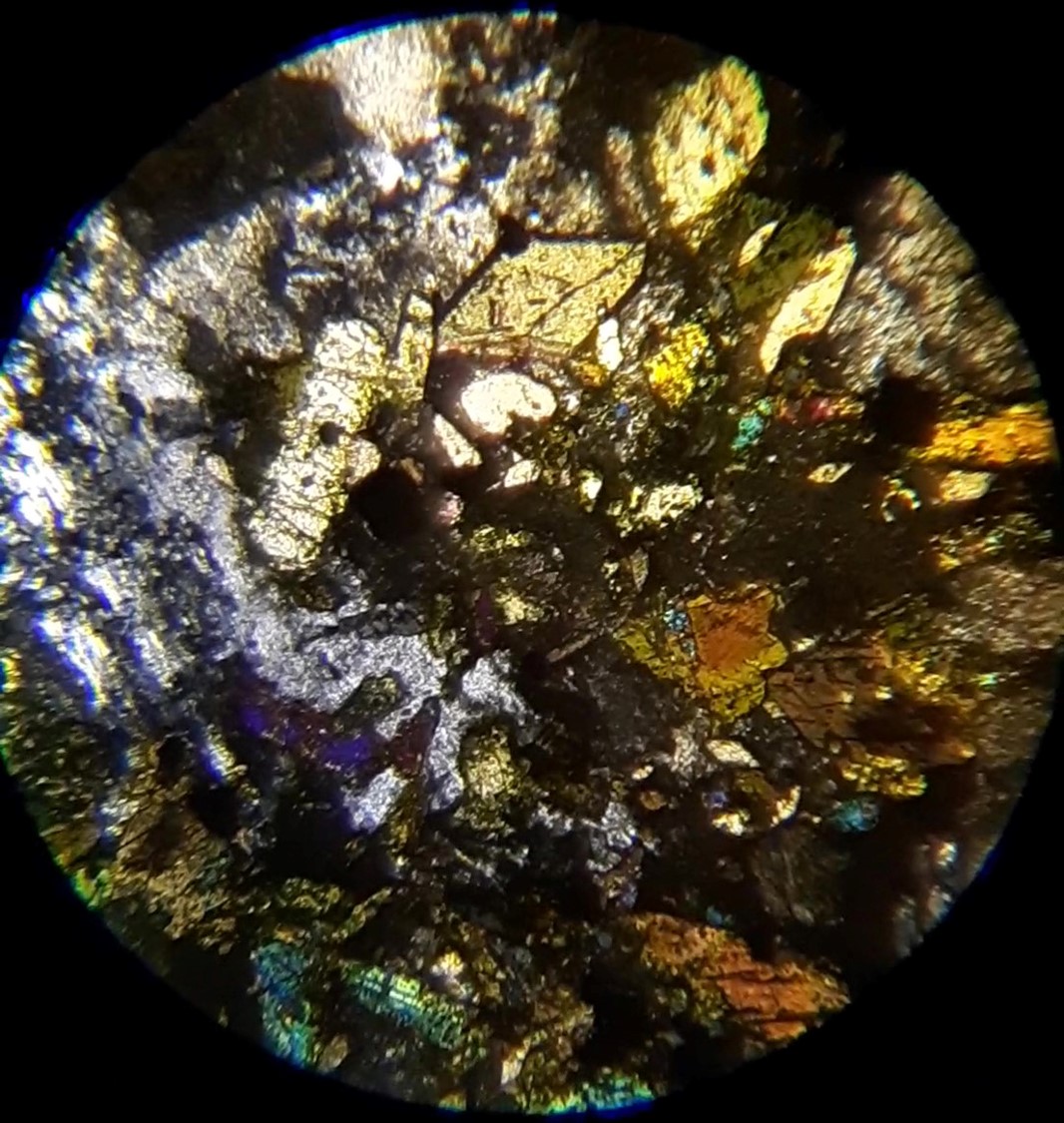Mineralogy-Petrology--Thin Sections Part 2--Textures
Earth Science Extras
by Russ Colson

Photomicrograph of zoned euhedral feldspar in aphanitc matrix under crossed Nicols.
Introduction
In Part 1 of these thin section exercises we practiced using a polarizing petrographic microscope and got some experience identifying a small set of common rock-forming minerals. In Part 2 we are going to look at a few basic textures and think about the stories that they tell us of the rock's formation. We will also identify (name) a few common rock types based on their mineralogy and texture.
Textures:
Texture refers the the size, shape, and arrangement of the constituents that make up a rock. There are many important textures to consider when examining a rock--you might review some of these online by searching on terms like "igneous rock textures", "metamorphic rock textures", and "sedimentary rock textures."
We are going to be looking at only a few basic textures and thinking about what they tell us. The textures we are going to consider are the following.
Crystalline: This refers the a texture in which the different constituents have crystallized together from a liquid state. It is a common texture in igneous rocks, although this word might also be used to describe the texture of some chemical sedimentary rocks, such as evaporites that have crystallized from water. Grains often have an interlocking and space filling quality that differs from the way that grains look if they have been gravity-deposited from water, for example.
Clastic (or Detrital): This refers to a texture in which the constituents are "stacked together" as they were deposited by settling. This texture is typical of detrital sedimentary rocks. Although we are not going to be considering size of particles in this lesson, the size of the clastic particles is a major criterion for naming of detrital sedimentary rocks. Some igneous rocks have also formed by some type of settling or accumulation, such as settling or other accumulation in a magma chamber. This texture in an igneous rock is usually called cumulate rather than detrital.
Foliated: This refers to a texture in which flat, wide, 'platy' constituents like muscovite or biotite have become orientied in parallel 'layers' through the work of differential stresses. Non-platy minerals like quartz can sometimes be flattened so as to lie parallel to the oriented platy minerals. This texture is typical of some types of metamorphic rock. Similar-looking texture in sedimentary rocks are formed by different processes and are given different names (lamination, layering, imbrication). Foliation that occurs in igneous rocks due to orientation of grains during lava flow are called flow foliation, or sometimes trachytic texture.
Aphanitic and phaneritic: These refer to textures in an igneous rock in which the crystal size is small (aphanitic) or large (phaneritic). Often the boundary between large and small is based on what can be seen in the field--particles too small to see with the naked eye are considered aphanitic, those large enough to see are called phaneritic. We do not use these words when describing sedimentary or metamorphic rocks.
Porphyritic: This refers to the texture of an igneous rock in which crystals of significantly different size are observed. The size difference usually must be on the order of one or more orders of magnitude, not just some grains being a few times bigger than other grains, and in particular grains of a particular mineralogy are much larger than other grains of the same mineralogy. Similar textures in metamorphic or sedimentary rocks would form by a quite-different process and would not be given the same name. A similar texture in a metamorphic rock would be called porphyroblastic. A similar texture in a sedimentary rock might be described as poorly sorted or bimodally sorted.
Immature or mature: These are interpretive descriptors for sedimentary rocks that usually reflect textures related to sorting and angularity as well as the types of minerals present. Maturity reflects how long that a sediment was weathered and moved about prior to final deposition. A mature sediment will generally be well sorted (mostly particles of the same size), well rounded (sharp corners of grains have been abraded off), and be composed of weather-stable minerals (like quartz and clay). Immature sediments will be poorly sorted (a wide mix of particle sizes), angular, and include (in addition to quartz and clay) less stable minerals (like feldspars, micas, perhaps amphiboles, and sometimes even mafic minerals like olivine and pyroxene-- in general the stability of minerals increases as one goes from mafic to felsic parts of the Bowen's Reaction Series).
Corona or reaction rim: A textural description in an igneous rock in which a particular grain or crystal is surrounded by a halo- or corona-like ring of a different mineral, the same mineral of a clearly different composition, or a complex intergrowth of different minerals that transitions into the surrounding rock. One example of this type of texture is addressed in the separate lesson on phase diagrams.
Zoning: A textural feature of igneous rocks in which a mineral grain consists of "zones" of different composition and/or extinction angle (not to be confused with twinning, however). A very common type of zoning that we will look at in this lesson is concentric zoning in which the interior of a grain has a different composition/extinction angle that the exterior, often showing up as a series of concentric bands. Typically with concentric zoning, the composition of the mineral grain transitions from that at the center to that at the rim. Origin of this type of texture is discussed in the separate lesson on phase diagrams.
Poikilitic: A texture in which multiple small crystals of one mineral or several minerals are inclosed within a much larger different mineral.
Cementation overgrowths: A feature of sedimentary rocks, usually quartz sandstones, in which the silica cement between quartz grains takes on the same crystallographic orientation as the original quartz grain, creating an overgrowth of that grain.
Exsolution texture: An igneous texture in which a single phase that has already solidified exsolves into two phases in the solid state, usually due to decreasing temperature. The origin of this type of texture is discussed in the separate lesson on phase diagrams. An example of this texture that we saw in Part 1 is the formation of perthite, which often appears mottled under crossed Nicols, with alternating, wavy blebs of the two intergrown phases.
Foam texture: This is a non-standard reference to a texture in metamorphic rocks in which some minerals (quartz for example) meet two other grains of the same mineral at 120 degree angles--the soap-bubble-like angle. This angle develops because it minimizes surface energy, which can happen during metamorphic reequilibration.
Euhedral, subhedral, anhedral: These are terms that indicate to what degree the mineral grain in an igneous rock has grown such as to clearly-display crystal form and faces (euhedral), no crystal form or faces (anhedral), or somewhere in between (subhedral). It is often an indication of how fast a magma cooled, and how much space the crystal had to grow in. Sometimes rapid cooling can produce what are called 'skeletal' textures which may have distinct complex geometrical patterns, but not directly reflect the crystal symmetry of the mineral.
Veining: These are vein-like or branching/wormy features that typically cut across the other structures and minerals in the rock and contain minerals that are generally different from the rest of the rock. (What does the fact that they cut across the the minerals and structures of the rock tell you about the age of the veins relative to the rest of the rock?)
There are many other terms for the wide variety of textures observed in rocks, each with different stories to tell. Here are a few. These are not part of the excersises below, but feel free to search on and read about them. You can also read about the non-bold textures that are listed above but not clearly defined.
- igneous: diabasic, ophitic, pegmatitic, pyroclastic (such as tuffaceous or volcanic breccia), vitreous (like obsidian), myrmekitic, graphic, miarolitic, amygdaloidal, xenolithic, cumulate
- Sedimentary: microcrystalline or cryptocrystalline (like chert), bioclastic, microclastic (like shale or mudstone), fossiliferous, imbrication. Sedimentary rocks also exhibit larger scale texture-like features, such as laminations, mudcracks, raindrop imprints, crossbedding, concretions, and ripple marks.
- Metamorphic: specific types of foliation (slaty cleavage, phyliitic, schistosity, banding), lineation, non-foliated (such as granoblastic or granulitic, ), augen, mylonitic. porphyroblastic, xenoblastic, ideoblastic, subideoblastic, poikiloblastic
Stories from Textures:
For the specific textures that we are going to be looking at, it's good to review what stories those textures tell us. Most of these can be inferred from the description of the texture, or are basic geological stories from introductory geology lessons, but feel free to search online for better understanding of the textures if you find that you can't complete the matching exercise below. Take some time to think about the problems below--don't just click through to get answers. Understanding the story that the textures tell us is the main point of this type of geological investigation--so don't scrimp on this step (it takes me at least 15 minutes to work through and answer these problems even though I wrote them--so if you are taking less time, you are probably doing more guessing than thinking, and that does not exercise your science reasoning skills--a major point of this exercise!).
To identify some textures (and also to name the metamorphic and igneous rock(s) below), you will need to figure out the size of the minerals seen under the microscope and compare them to the size of particle that you can see with the naked eye. The image below shows the scale of the microscope view that we are using in these Thin Section lessons. Each increment in the scale is 0.01 mm. The numbers indicate increments of 0.1 mm. The entire scale is 2 mm wide. The smallest that the human eye can typically see is around 0.06 mm, or about 0.6 on the scale shown, giving you a way to estimate, for example, the boundary between aphanitic and phaneritic for igneous rocks, silt versus sand size for sedimentary rocks, and the coarser schist and gneiss versus finer slate and phyllite for metamorphic rocks.
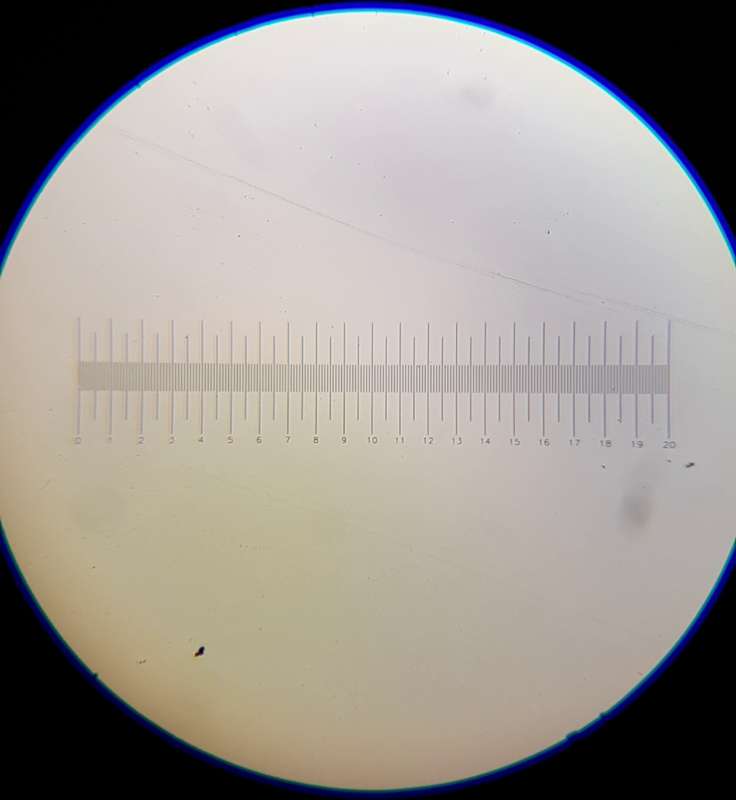
Practice Recognizing Textures
Identify the textures requested in the images below (click on pictures to expand and rotate stage--plane light on the left, crossed Nicols on the right)
Identify the textures requested in the images below (click on pictures to expand and rotate stage--plane light on the left, crossed Nicols on the right)
Identify the textures requested in the images below (click on pictures to expand and rotate stage--plane light on the left, crossed Nicols on the right)
Identify the textures requested in the images below (click on pictures to expand and rotate stage--plane light on the left, crossed Nicols on the right)
Identify the textures requested in the images below (click on pictures to expand and rotate stage--plane light on the left, crossed Nicols on the right)
Identify the textures requested in the images below (click on pictures to expand and rotate stage--plane light on the left, crossed Nicols on the right)
Identify the textures requested in the images below (click on pictures to expand and rotate stage--plane light on the left, crossed Nicols on the right)
Identify the textures requested in the images below (click on pictures to expand and rotate stage--plane light on the left, crossed Nicols on the right)
Identify the textures requested in the images below (click on pictures to expand and rotate stage--plane light on the left, crossed Nicols on the right)
Identify the textures requested in the images below (click on pictures to expand and rotate stage--plane light on the left, crossed Nicols on the right)
Identify the textures requested in the images below. Note that plane light and crossed-Nicols are combined in this sample, which gives you the ablity to "blink" back and forth between plane light and crossed-Nicols—a helpful ability for this sample.
Identify the textures requested in the images below. Note that plane light and crossed-Nicols are combined in this sample, which gives you the ablity to "blink" back and forth between plane light and crossed-Nicols—a helpful ability for this sample.
Identify the textures requested in the images below (click on pictures to expand and rotate stage--plane light on the left, crossed Nicols on the right)
Identify the textures requested in the images below (click on pictures to expand and rotate stage--plane light on the left, crossed Nicols on the right)
Naming Rocks--Texture and Mineralogy
The igneous rocks that we are going to look at are fairly common rock types, so, in naming them, we are going to consider the simple Bowen's Reaction Series diagram below (from the lesson on phase diagrams), rather than the Streckeisen diagram, which is normally used for igneous rock classification. Remember from the phase diagram lesson that olivine and quartz do not typically coexist at eqiulibrium, and that the proportions of quartz, alkali feldspar (like orthoclase), and the albitic (Na-rich) component of plagioclase all increase with decreasing temperature and increasing silica. The aphanitic and phaneritic columns in the diagram are based on texture rather than mineralogy, thus basalt and gabbro have the same mineralogy as each other (generally) but have different textures, and thus they have different stories to tell. Remember that porphyritic rocks are named according to the smaller grain size, not the larger, so a mafic rock with large crystals of olivine in a matrix that is too small to see would be called a porphyritic basalt, not a gabbro.
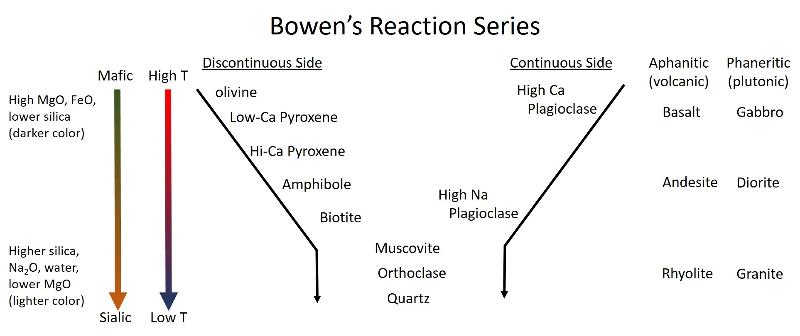
To name our sedimentary rocks, we are going to use the version of the Folk QFR classification shown below. We reviewed how to read a triangular diagram in the phase diagram lessons, however, as a reminder, the total percentage for the three components Q (quartz and chert), F (feldspars, including plagioclase and alkali feldspar), and rock fragments (lithic fragments of pre-existing rock containing a variety of minerals) add to 100%. The percentage of any one component is 100% at that component's corner, decreasing to 0% in lines parallel to and going toward the side opposite the corner.

For naming metamorphic rocks, we are only going to look at foliated rocks, and we will only distinguish between rocks with crystals big enough to see (e.g. schist and gneiss) versus those not big enough to see (e.g. slate, phyllite).
Practicing Rock Identification
Identify the rock in the images below--containing feldspar, hornblende, some minor quartz (click on pictures to expand and rotate stage--plane light on the left, crossed Nicols on the right)
Identify the rock in the images below--containing quartz (click on picture to expand and rotate stage--with both plane light and crossed Nicols)
Identify the rock in the images below--containing plagioclase, olivine, and pyroxene (click on pictures to expand and rotate stage--plane light on the left, crossed Nicols on the right)
Identify the rock in the images below--containing feldspar, hornblende, opaques, and some quartz (click on pictures to expand and rotate stage--plane light on the left, crossed Nicols on the right)
Identify the rock in the images below--containing plagioclase, perthite, muscovite, and quartz (click on picture to expand and rotate stage--with both plane light and crossed Nicols)
Identify the rock in the images below--containing plagioclase, perthite (alkali feldspar), hornblende, biotite, opaques, and abundant quartz (click on pictures to expand and rotate stage--plane light on the left, crossed Nicols on the right)
Identify the rock in the images below--containing muscovite, biotite, quarz, and garnet (click on pictures to expand and rotate stage--plane light on the left, crossed Nicols on the right)
Stories of Rock Types:
Igneous rock types can occur at many different types of plate boundaries and different plate boundaries can exhibit many different types of igneous rock. However, certain rock types can be said to be more "characteristic" of certain types of boundaries. For each of the rocks below, identify its 'characteristic' plate boundary.
Identify the rock in the images below and its 'characteristic' plate tectonic setting
Identify the rock in the images below and its 'characteristic' plate tectonic setting
The rock below is not one that we have looked at previously. It contains nepheline, a feldspathoid, as well as an unusual greenish Na-rich pyroxene and hornblende. The diamond-shaped mineral is titanite (formerly called sphene). Quartz and nepheline are not stable together, and the presence of nepheline indicates that the rock is silica-undersaturated, meaning that quartz won't crystallize from a magma of this composition. -- Partial melting of mantle material at higher pressure tends to produce lower silica and higher alkali content (Na and K) than partial melting at lower pressure. Thus, melting beneath thick continents produces more silica-poor magmas, which can sometimes be silica undersaturated, like this sample from Magnet Cove Arkansas.
Identify the rock in the images below and its 'characteristic' plate tectonic setting
This ends Part 2--the identification of common rock textures and the stories that we can tell based on rock texture and composition. In part 3 we will look at a couple of limestones, one fossiliferous and one oolitic.
last updated 4/24/2021. Text and pictures are the property of Russ Colson.
